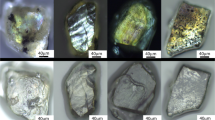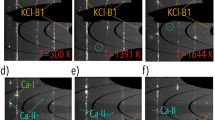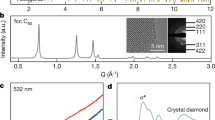Abstract
DIAMOND is generally thought to be one of the most perfect crystals occurring naturally: its atomic structure was first investigated in the very early days of X-ray crystal analysis. It turned out that the atoms of the crystal were arranged on two interpenetrating face-centred cubic lattices, the corner of one cube lying one quarter of the way along the cube diagonal of the other. Whether the resulting crystal possessed full octahedral symmetry or was of the lower tetrahedral type, a question on which crystallographers were divided, could not be settled by the additional X-ray evidence. Some ten years ago, new interest in the structure of diamond was aroused by the work of Robertson, Fox and Martin1, who showed that the infra-red absorption and ultraviolet transparency of diamonds placed them in two classes. Of the two types, the first and commoner was opaque to both infra-red and ultra-violet radiation, while the second, Type II, is rare and is transparent to these radiations. The more recent X-ray investigations of Lonsdale and Smith2 have shown that although the two types are structurally identical on an atomic scale, there are abnormalities in the diffraction patterns of Type I diamonds which suggest some kind of 'mosaic' structural difference in the two types. Dr. Lonsdale's observed effects are in fact very similar to the kind of abnormality observed in the X-ray spectra of age-hardened alloys and alloys with high magnetic coercivity; they suggest a laminated structure.
This is a preview of subscription content, access via your institution
Access options
Subscribe to this journal
Receive 51 print issues and online access
$199.00 per year
only $3.90 per issue
Buy this article
- Purchase on Springer Link
- Instant access to full article PDF
Prices may be subject to local taxes which are calculated during checkout
Similar content being viewed by others
References
Robertson, Fox and Martin, Phil. Trans. Roy. Soc., A, 232, 463 (1934); Proc. Roy. Soc., A, 157, 579 (1936).
Lonsdale and Smith, Nature, 148, 112 (1941).
Raman and others., Proc. Indian Acad. Sci., Bangalore, 189–342 (1944).
Rights and permissions
About this article
Cite this article
PRESTON, G. Structure of Diamond. Nature 155, 69–70 (1945). https://doi.org/10.1038/155069a0
Issue Date:
DOI: https://doi.org/10.1038/155069a0
This article is cited by
-
The Preston of the Guinier-Preston Zones. Guinier
Metallurgical and Materials Transactions B (2010)
-
The Preston of the Guinier-Preston Zones. Guinier
Metallurgical and Materials Transactions A (2010)
Comments
By submitting a comment you agree to abide by our Terms and Community Guidelines. If you find something abusive or that does not comply with our terms or guidelines please flag it as inappropriate.



